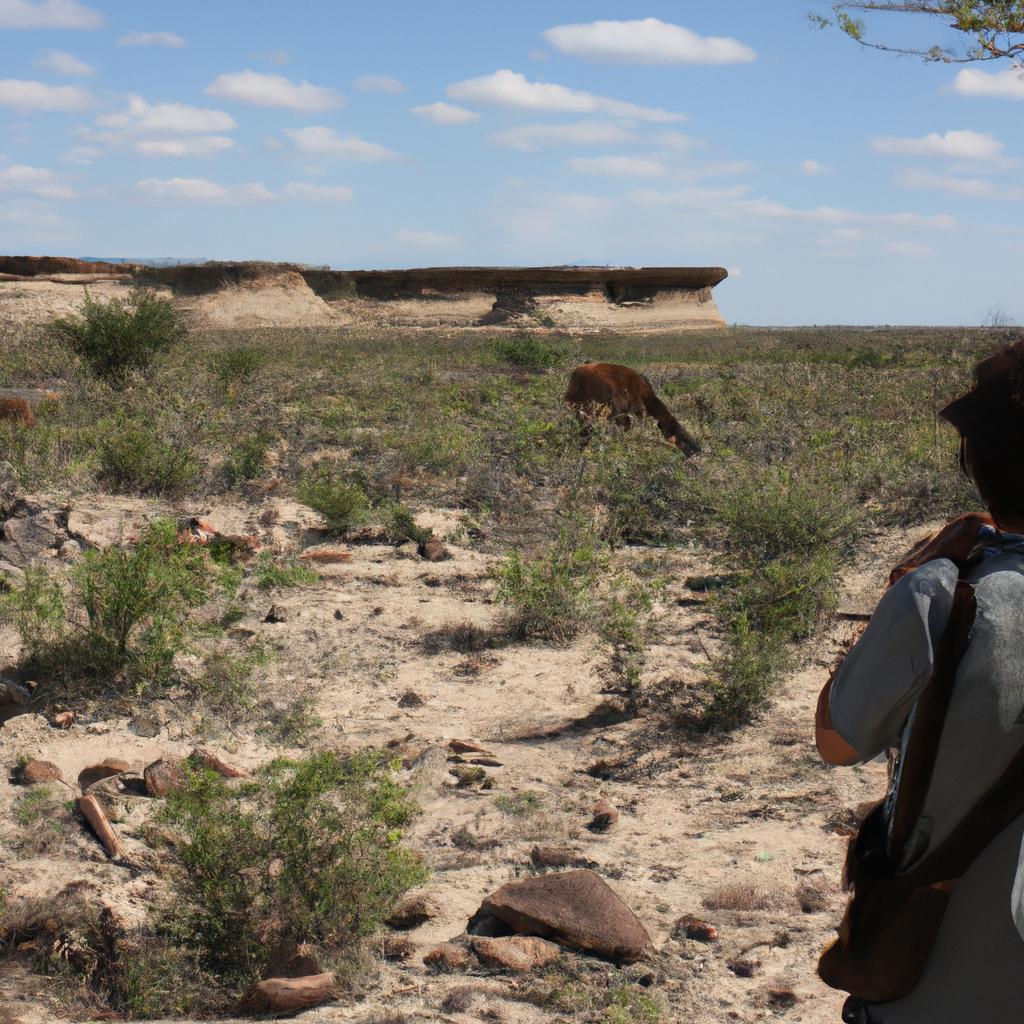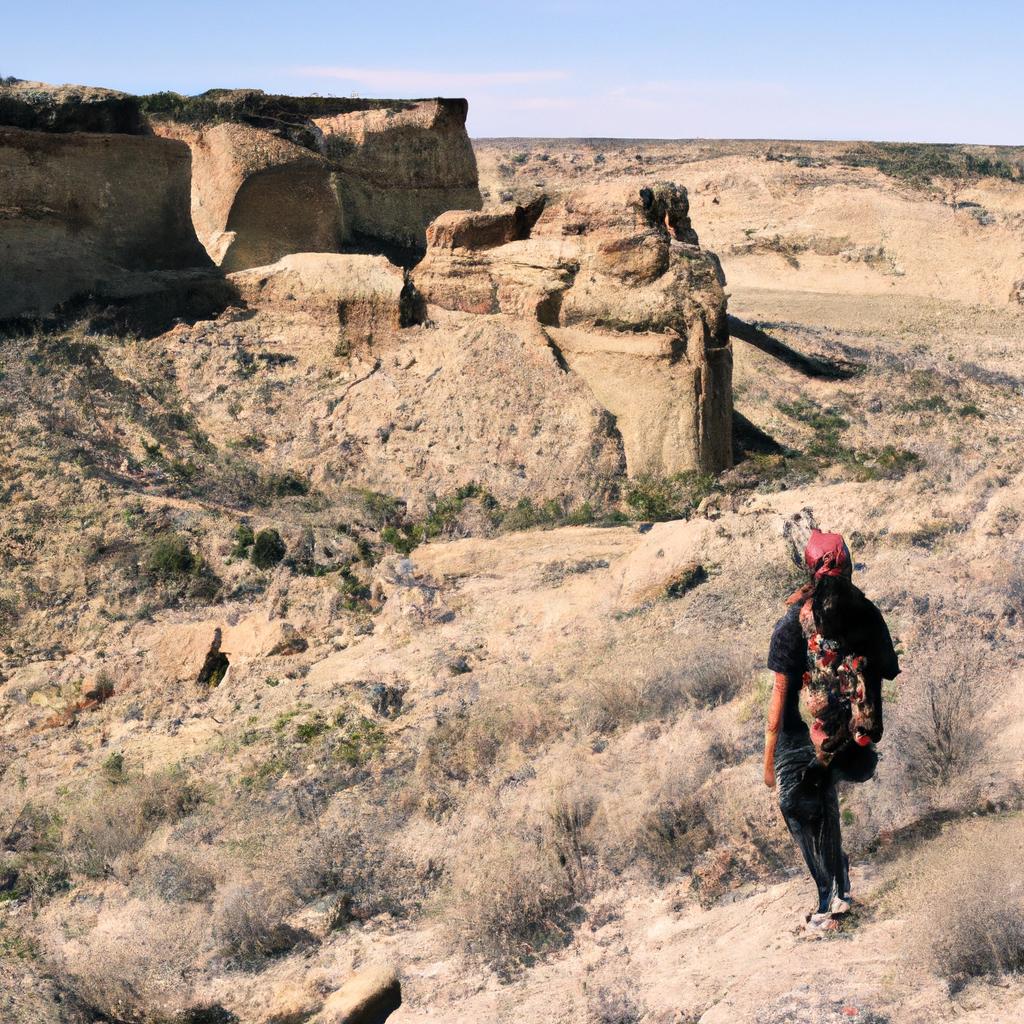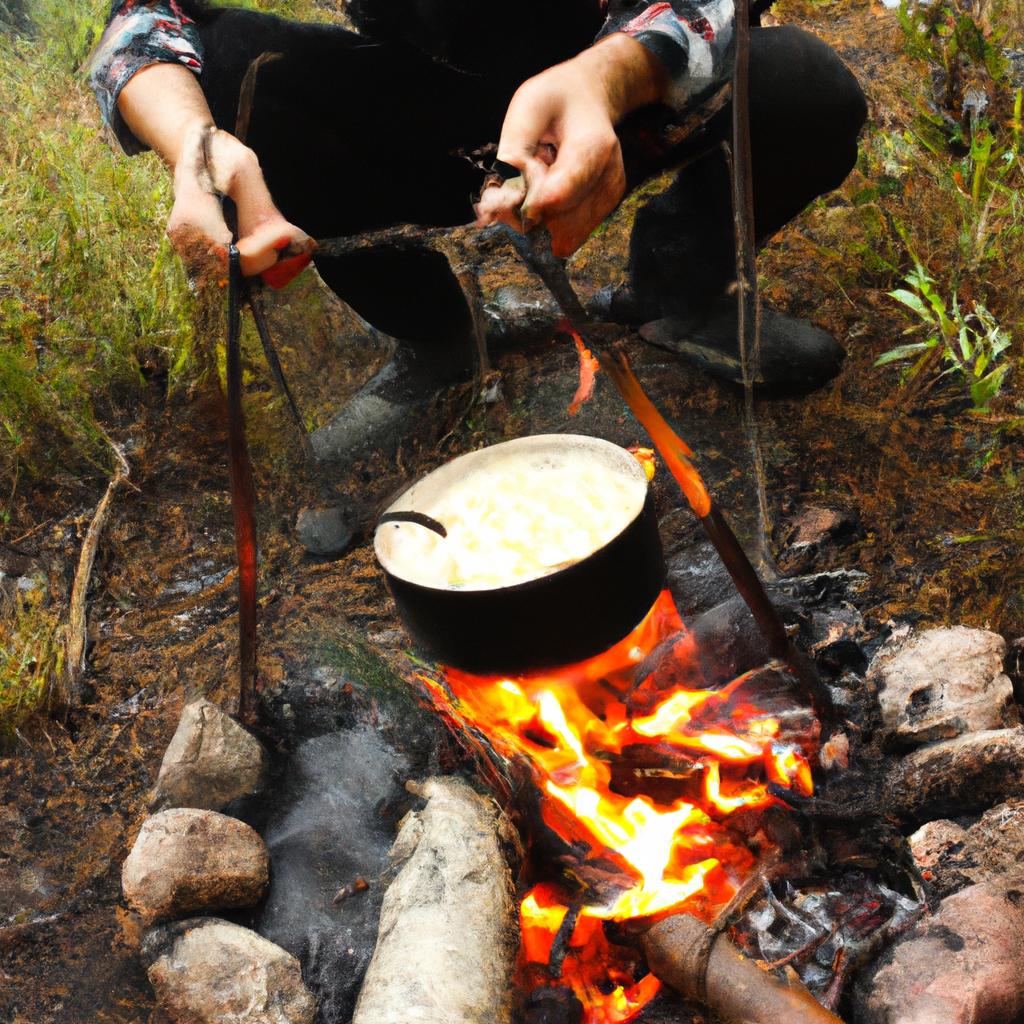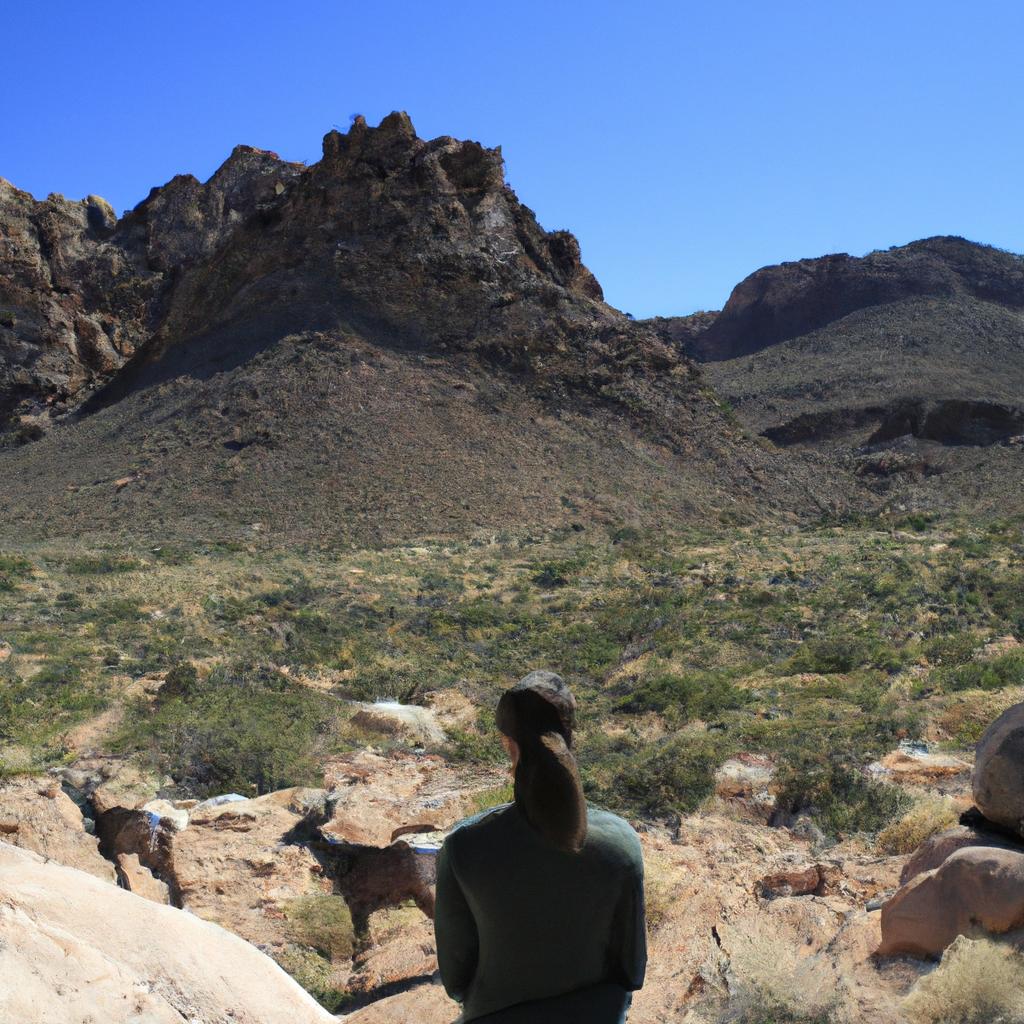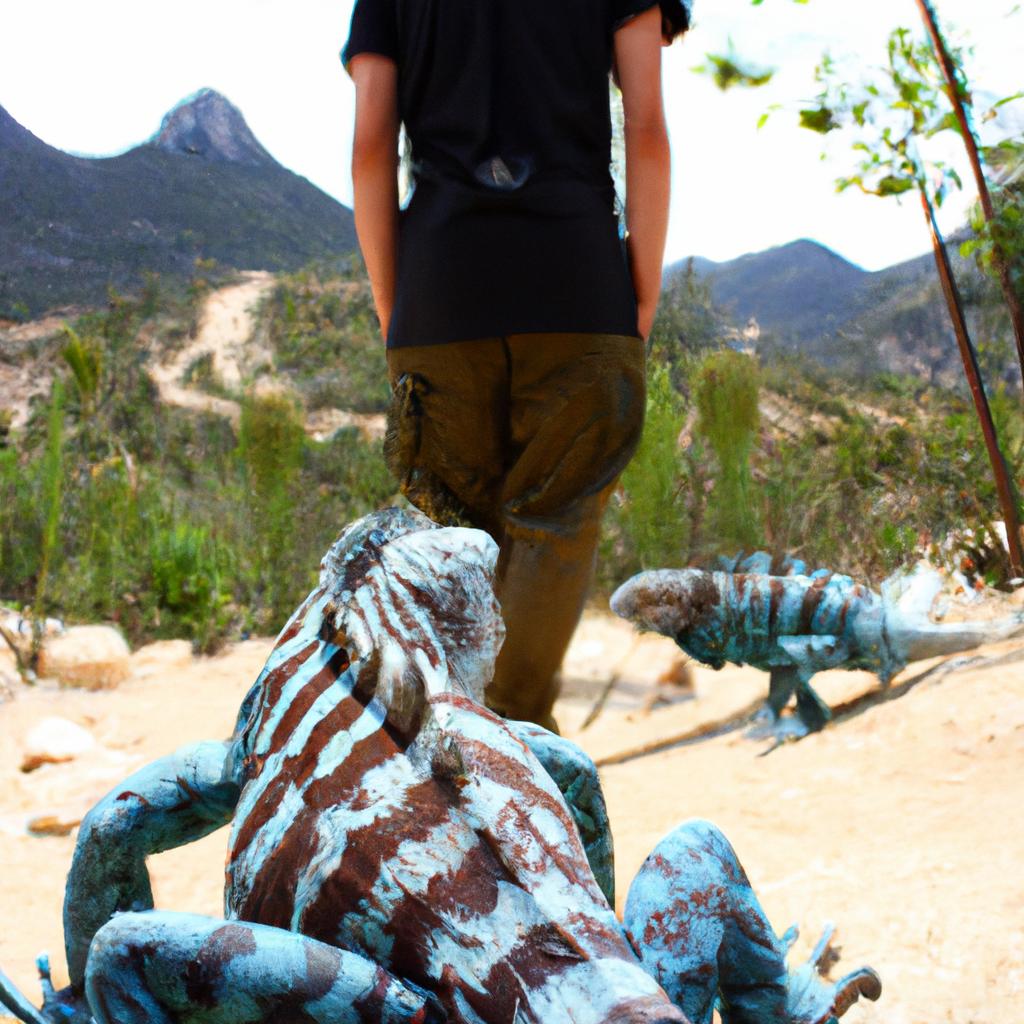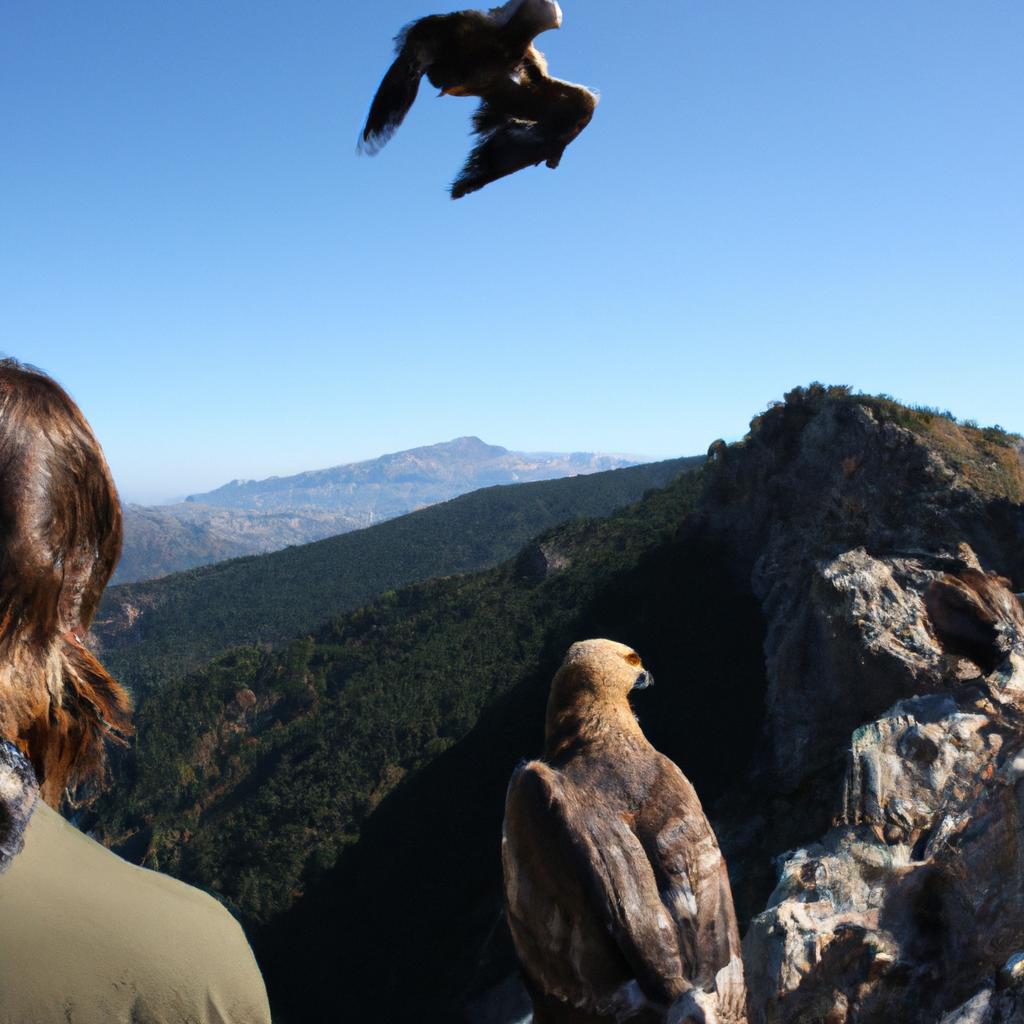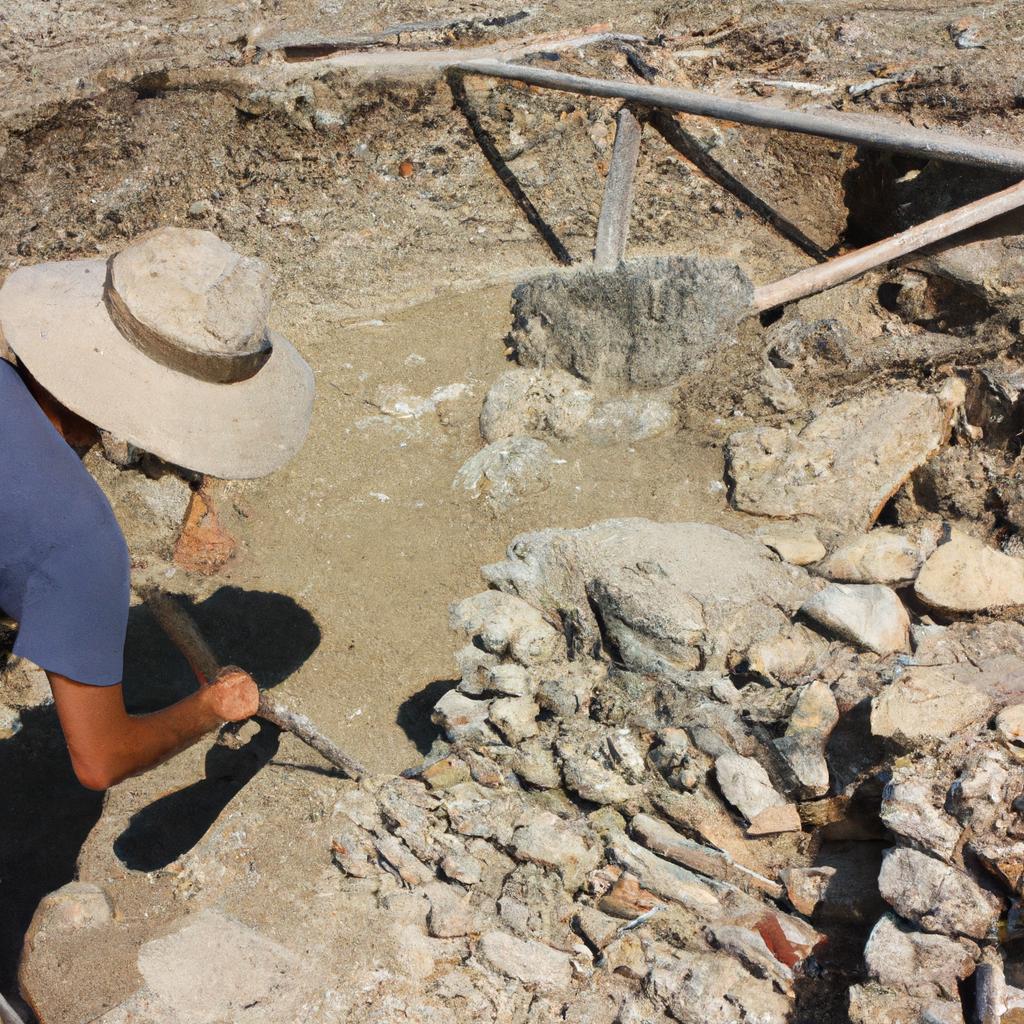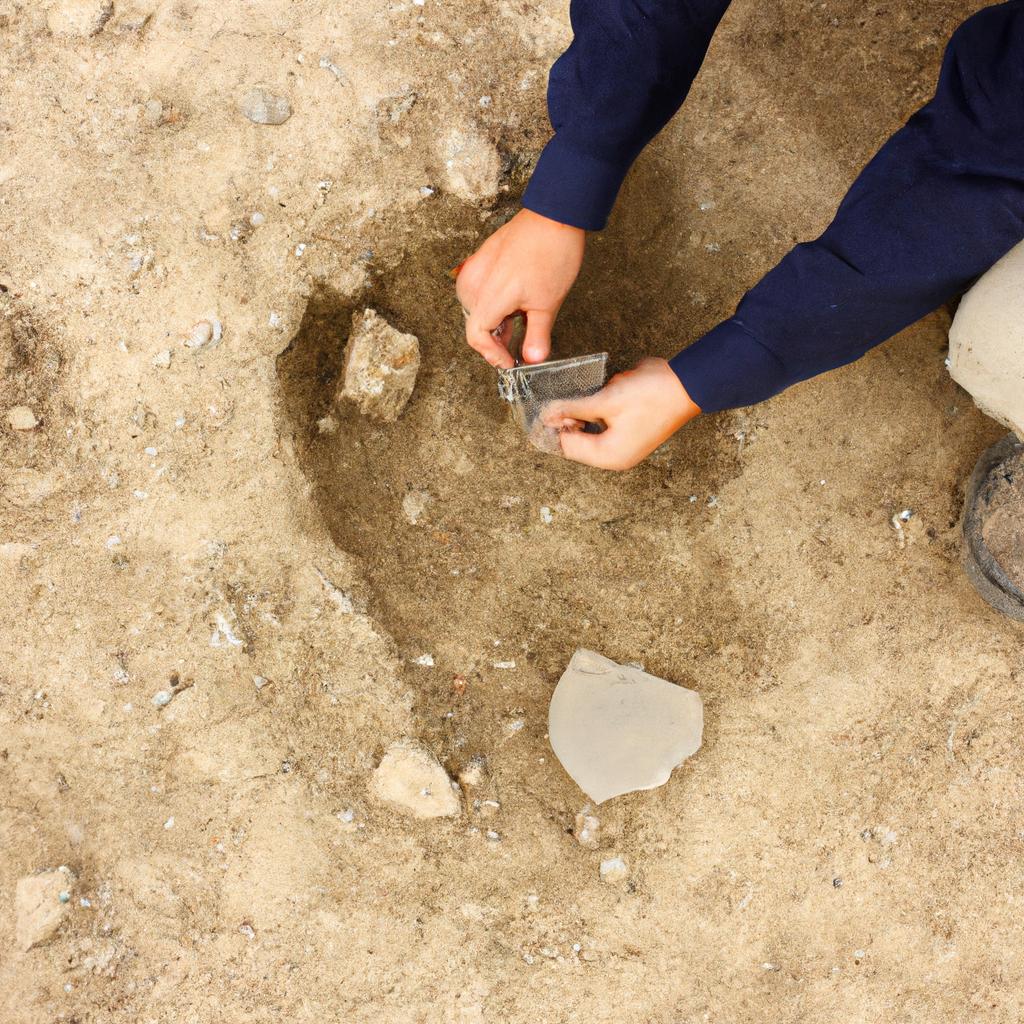Chaco Canyon, located in the southwestern United States, is a mesmerizing destination for outdoor enthusiasts and history buffs alike. The canyon boasts an extensive network of ancient ruins that provide insight into the rich cultural heritage of the ancestral Puebloan people who once inhabited the region. For travelers seeking to immerse themselves in this unique blend of natural beauty and historical significance, camping in Chaco Canyon offers an unparalleled experience.
For instance, imagine arriving at Chaco Canyon during sunset, with hues of orange and pink painting the sky above towering sandstone cliffs. As you set up camp amidst the peaceful desert landscape, you can’t help but feel a deep sense of connection to both nature and history. This article serves as a comprehensive guide for those planning to embark on a camping adventure in Chaco Canyon, providing essential information on logistics, recommended campsites, activities to indulge in while staying there, and tips for making the most out of your visit.
In the following sections, we will delve into vital details such as park regulations and permits required for camping within Chaco Culture National Historical Park. We will also highlight some of the most popular campsites known for their scenic views and proximity to key attractions like Pueblo Bonito and Casa Rinconada. Additionally, we will discuss the various activities you can engage in while camping in Chaco Canyon, including hiking through ancient ruins, stargazing under the dark desert skies, and attending ranger-led programs to learn more about the cultural significance of the area.
Furthermore, we will provide some useful tips to enhance your camping experience. These might include packing essential gear such as a sturdy tent, comfortable sleeping bag, and proper outdoor clothing. We will also offer advice on planning your meals and staying hydrated in the arid desert climate.
Finally, we will address any specific questions or concerns you may have regarding camping in Chaco Canyon. Whether it’s about safety precautions, accessibility for individuals with disabilities, or recommendations for nearby attractions to explore during your visit, our goal is to ensure that you have all the necessary information to make your camping trip a memorable one.
So get ready to embark on an unforgettable adventure in Chaco Canyon as we guide you through every step of planning and experiencing this breathtaking destination.
Preparing Delicious Meals Outdoors
Imagine sitting around a crackling campfire in the heart of Chaco Canyon, surrounded by ancient ruins and breathtaking landscapes. As you soak up the serenity of this majestic place, your stomach growls, reminding you that it’s time to prepare a delicious meal under the open sky. In this section, we will explore some essential tips and techniques for creating memorable outdoor dining experiences during your camping trip.
To begin with, planning is key when it comes to preparing meals outdoors. Before embarking on your adventure, take inventory of your cooking equipment and supplies. Make a detailed list of all the ingredients you’ll need for each dish and ensure that they are properly packed and easily accessible within your camping gear. This not only saves time but also ensures that you have everything required to whip up mouthwatering meals without any hiccups along the way.
Once at your campsite, finding inspiration from local cuisine can elevate your outdoor culinary experience. Incorporating regional flavors into your dishes allows you to connect more deeply with the surroundings while adding an element of novelty to traditional recipes. For example, imagine infusing smoky chipotle peppers into a hearty chili or incorporating native herbs like sage or juniper berries in roasted vegetables for added complexity. By embracing these local elements, you create unique tastes that reflect both nature’s bounty and cultural heritage.
When it comes to executing outdoor cooking methods successfully, mastering fire management is crucial. Whether using a portable grill or open flames, understanding heat control is essential for achieving desirable results every time. Utilize indirect heat zones by arranging coals accordingly or adjust flame intensity as needed for different cooking techniques such as grilling or simmering. Additionally, be mindful of food safety practices by ensuring proper storage temperatures for perishable items and using separate cutting boards for raw meats and fresh produce.
To evoke an emotional response in our audience:
- Enjoying sizzling steaks seared to perfection while the sunset casts a warm glow over the canyon.
- Savoring hearty stews that fill the air with tantalizing aromas, reminding you of cozy gatherings around a campfire.
- Delighting in fresh salads infused with local herbs and crisp vegetables, evoking a sense of connection to nature’s bounty.
- Indulging in decadent desserts like gooey s’mores that bring back childhood memories of carefree summer nights.
Moreover, here is an example table showcasing different regional ingredients commonly used in Chaco Canyon:
| Ingredient | Flavor Profile | Cultural Significance |
|---|---|---|
| Corn | Earthy, Sweet | Staple crop for Pueblo people |
| Green Chile | Spicy, Smoky | Essential ingredient in New Mexican cuisine |
| Pinon Nuts | Nutty, Buttery | Traditional food source for Native American tribes |
| Juniper Berries | Woody, Resinous | Used medicinally by Indigenous cultures |
In summary, preparing delicious meals outdoors requires careful planning, drawing inspiration from local cuisine, and mastering fire management. By incorporating regional flavors into your dishes and embracing cooking techniques suited for outdoor environments, you can create unforgettable dining experiences amidst the awe-inspiring beauty of Chaco Canyon.
Exploring the Natural Beauty
Transitioning from the previous section on preparing delicious meals outdoors, let us now delve into exploring the natural beauty that Chaco Canyon has to offer. Imagine yourself standing at the edge of Fajada Butte, a prominent mesa in the canyon. As you gaze out onto the vast landscape before you, it becomes evident why this UNESCO World Heritage Site is renowned for its breathtaking scenery and archaeological significance.
When embarking on your exploration of Chaco Canyon’s natural wonders, there are several key aspects to consider:
-
Geological Marvels: The unique geological formations found within Chaco Canyon provide a glimpse into the Earth’s ancient history. From towering sandstone cliffs carved by millions of years of erosion to intricate rock art adorning cave walls, each formation tells a story of time immemorial.
-
Flora and Fauna: Despite being located in an arid region, Chaco Canyon boasts a surprising diversity of plant and animal life. Cacti such as prickly pears and cholla dot the landscape, while hardy desert shrubs like sagebrush thrive in this harsh environment. Keep an eye out for elusive creatures like coyotes, jackrabbits, and even bobcats during your journey through this rugged terrain.
-
Night Sky Spectacles: At nightfall, prepare to be awe-struck by the celestial display above Chaco Canyon. With limited light pollution in the area, stargazers can indulge in unparalleled views of constellations twinkling against a backdrop of deep black sky—truly an unforgettable experience for any astronomer or nature enthusiast.
-
Tranquility and Solitude: One cannot overlook the tranquility that permeates every corner of Chaco Canyon. Away from bustling cities and crowds, visitors have an opportunity to reconnect with nature and find solace amidst these peaceful surroundings—a chance to unwind and rejuvenate their spirits.
To further illustrate the splendor awaiting travelers at Chaco Canyon, consider the following table:
| Natural Wonders | Description | Emotional Response |
|---|---|---|
| Fajada Butte | Towering mesa offering panoramic views | Awe-inspiring |
| Petroglyphs | Ancient rock carvings depicting past lives | Intriguing |
| Chaco Wash | Serpentine waterway meandering through sandstone cliffs | Captivating |
| Pueblo Bonito | Ruins of an ancient Ancestral Puebloan community | Enchanting |
As you conclude your exploration of Chaco Canyon’s natural beauty, be prepared to transition into observing native wildlife. The diverse range of animals indigenous to this region provides a captivating glimpse into their unique adaptations and role within this delicate ecosystem.
Observing Native Wildlife
As visitors embark on their journey to Chaco Canyon, they are greeted by a breathtaking landscape that exudes an air of tranquility and mystery. The natural beauty found within this archaeological wonderland is truly awe-inspiring. One can almost imagine the ancient civilizations that once thrived in this very place, living harmoniously with nature. For instance, picture yourself standing atop Fajada Butte, watching as the golden hues of sunlight dance upon the vast canyon below.
To fully immerse oneself in the natural wonders of Chaco Canyon, there are several key areas worth exploring:
-
Pueblo Bonito Trail: This trail takes you on a winding path through the heart of Chacoan civilization. As you hike along, keep your eyes peeled for remnants of ancient dwellings and kivas nestled among towering sandstone cliffs.
-
Kin Kletso Overlook: Offering panoramic views of the surrounding wilderness, Kin Kletso overlook provides a perfect vantage point to marvel at the sheer magnitude of Chaco Canyon’s geological formations.
-
Wijiji Trail: Traverse through time as you follow the footsteps of ancestral Puebloans along this well-preserved trail leading to Wijiji Ruins. Take note of petroglyphs etched into rock faces — whispers from past inhabitants telling stories untold.
-
Casa Rinconada: Standing proudly amidst the desert plains is Casa Rinconada -a remarkable great kiva that served as a center for community gatherings and ceremonies centuries ago. Step back in time as you explore its circular walls and envision life as it once was.
In addition to these captivating locations, let us not forget about the rich wildlife inhabiting Chaco Canyon’s rugged terrain. Below is a table showcasing some notable species one might encounter during their expedition:
| Species | Description | Notable Features |
|---|---|---|
| Coyote | A cunning and adaptable predator | Howling in the moonlit night |
| Golden Eagle | Majestic raptors soaring through the sky | Wingspan up to 7 feet |
| Mule Deer | Graceful herbivores roaming the canyon | Large, distinctive ears |
| Kangaroo Rat | Nocturnal mammals with unique jumping abilities | Long kangaroo-like hind legs |
As one traverses the trails of Chaco Canyon, surrounded by its awe-inspiring natural beauty and encounters its diverse wildlife, a sense of wonder and appreciation for this ancient land is sure to permeate every step. With each passing moment spent exploring these remarkable sites, visitors are transported back in time, allowing them to connect on a deeper level with both nature and history.
Transitioning seamlessly into the subsequent section about “Unforgettable Bird-Watching Experiences,” bird enthusiasts will find themselves captivated by the avian wonders that grace Chaco Canyon’s skies. The vibrant plumage and melodic songs of various species create an enchanting symphony against the backdrop of towering cliffs and sprawling deserts.
Unforgettable Bird-Watching Experiences
Exploring the ancient ruins of Chaco Canyon is not only a fascinating historical experience but also an opportunity to observe a diverse array of native wildlife. As you wander through this archaeological wonder, keep your eyes peeled for some remarkable encounters with animals that have called this place home for centuries.
Imagine standing in awe as you catch sight of a majestic coyote gracefully trotting across the vast landscape. These resilient creatures are well adapted to survive in the arid environment and can be seen scavenging for food or patrolling their territories. While they may appear elusive, patient travelers might witness these wild canines hunting or howling under the starry night sky.
To fully appreciate the richness of Chaco Canyon’s wildlife, here are four things you should bear in mind during your visit:
- Respect boundaries: Remember that you are entering the natural habitat of these animals; therefore, it is crucial to maintain a safe distance at all times.
- Stay silent: Wildlife tends to shy away from loud noises, so try to minimize any unnecessary sounds to increase your chances of spotting them.
- Bring binoculars: Some species, such as birds and small mammals, may require closer observation. Binoculars will enable you to appreciate intricate details without disturbing their natural behavior.
- Be patient: Observing wildlife often requires patience and persistence. Take your time exploring different areas within the canyon and allow nature to reveal its wonders at its own pace.
| Species | Description | Habitat |
|---|---|---|
| Mule Deer | Graceful herbivores with large ears | Open meadows |
| Golden Eagle | Majestic raptors with impressive wingspan | Cliff faces |
| Prairie Dog | Social rodents known for burrowing | Grasslands near streams |
| Kangaroo Rat | Nocturnal desert dwellers with long tails | Sandy soil and dunes |
Witnessing the wonders of Chaco Canyon’s wildlife can be an awe-inspiring experience, connecting you to the natural world in a profound way. As you continue your journey through this ancient landscape, keep these encounters as lasting memories that remind us of our interconnectedness with nature.
Next, we will provide some valuable tips for cooking over an open fire during your camping adventure in Chaco Canyon. So get ready to ignite your culinary skills amidst the stunning beauty of this historical site.
Tips for Cooking over an Open Fire
Camping in Chaco Canyon: A Traveler’s Guide
As travelers explore the captivating landscapes of Chaco Canyon, they are greeted by more than just stunning vistas. The area is renowned for its diverse bird population, offering visitors an unforgettable bird-watching experience. Imagine finding yourself surrounded by a symphony of birdsong as you witness these majestic creatures soaring through the canyon.
One such example of this enchanting encounter involves the sighting of a rare Black-throated Sparrow nesting among the ancient ruins. This small and elusive bird, known for its striking black throat patch, exemplifies the unique avian diversity found within Chaco Canyon.
To enhance your own bird-watching adventure, consider following these tips:
- Be patient and observant: Birds can be quite stealthy, so take your time to seek out their habitats.
- Bring binoculars or a camera with telephoto lens: These tools will allow you to observe birds from a distance without disturbing them.
- Learn about local species: Familiarize yourself with common birds found in Chaco Canyon to better identify and appreciate their presence.
- Visit during different times of day: Birds display varying behaviors at different hours, so experiencing morning chirps or evening flights can offer distinct encounters.
Table 1 showcases some noteworthy bird species that call Chaco Canyon home:
| Species | Appearance | Habitat |
|---|---|---|
| Western Tanager | Vibrant red head & yellow body | Pine forests |
| Swainson’s Hawk | Broad wingspan & white underparts | Open grasslands |
| Vermilion Flycatcher | Bright red plumage & crested head | Riparian areas |
| Cactus Wren | Long tail & distinctive white eyestripe | Desert scrubland |
Immersing oneself in the world of bird-watching within Chaco Canyon offers a unique opportunity to appreciate the wonders of nature. Observing these incredible creatures in their natural habitats serves as a reminder of the delicate balance and interconnectedness of ecosystems.
As you move beyond the realm of avian discoveries, prepare yourself for an exploration that unveils the hidden treasures nestled within Chaco Canyon’s hiking trails. The next section will guide you through this thrilling adventure, immersing you in the awe-inspiring beauty waiting to be discovered just steps away from your campsite.
Discovering Hidden Hiking Trails
Building on the knowledge of cooking over an open fire, let us now delve into another exciting aspect of camping in Chaco Canyon – discovering hidden Hiking Trails.
Section H2: Discovering Hidden Hiking Trails
To truly immerse yourself in the beauty and history of Chaco Canyon, venturing off the beaten path is essential. While many visitors flock to the well-known sites such as Pueblo Bonito or Casa Rinconada, there are numerous hidden hiking trails that offer a more intimate experience with this remarkable landscape.
Imagine stumbling upon an abandoned cliff dwelling nestled within a secluded canyon, its walls adorned with ancient petroglyphs telling stories from centuries past. Such encounters are not uncommon for those who venture beyond the tourist hotspots. One notable example is the trail leading to Penasco Blanco, a lesser-known Great House situated atop a mesa overlooking the vast expanse of Chaco Canyon. This remote location offers solitude and breathtaking panoramic views that few have had the privilege to witness.
Embarking on these hidden hiking trails requires careful preparation and respect for nature’s delicate balance. Here are some tips to ensure you make the most out of your explorations:
- Stay hydrated: Carry plenty of water, especially during warm weather.
- Wear appropriate footwear: Sturdy shoes with good traction will help navigate uneven terrain safely.
- Pack essentials: Bring sunscreen, insect repellent, and a first aid kit to address any unexpected needs.
- Leave no trace: Preserve the pristine environment by adhering to principles of minimal impact camping.
In addition to these valuable tips, it may be helpful to familiarize yourself with some noteworthy hidden hikes within Chaco Canyon:
| Trail Name | Difficulty Level | Highlights |
|---|---|---|
| Kin Kletso Loop | Moderate | Scenic loop showcasing Ancestral Puebloan ruins |
| Hungo Pavi Loop | Easy | Tranquil hike leading to a partially excavated Great House |
| Wijiji Trail | Easy | Opportunity to see ancient petroglyphs |
| South Mesa Loop | Difficult | Challenging trek offering stunning views |
By venturing off the well-trodden path, you will not only discover hidden gems but also experience a deeper connection with the rich cultural heritage of Chaco Canyon. As you continue your journey through this awe-inspiring landscape, keep an eye out for our next section on spotting rare animals in their natural habitat.
Moving on from discovering hidden hiking trails, let us now delve into the exciting world of spotting rare animals in their habitat without disturbing them.
Spotting Rare Animals in their Habitat
As you navigate through the hidden gems of Chaco Canyon, don’t miss out on the opportunity to witness its diverse wildlife. From elusive creatures that blend seamlessly into their surroundings to majestic animals gracefully roaming the land, Chaco Canyon is a haven for nature enthusiasts. In this section, we will delve into the remarkable experience of spotting rare animals in their natural habitat.
Paragraph 1:
Imagine yourself standing still amidst the vastness of Chaco Canyon when suddenly, you spot movement out of the corner of your eye. As you turn your gaze towards it, you find yourself face-to-face with a magnificent bobcat stealthily prowling through the desert vegetation. This encounter highlights just one example of the incredible wildlife encounters that await visitors to Chaco Canyon.
To fully appreciate and engage with the unique fauna present here, keep these tips in mind:
- Be patient and observant; sometimes animals may reveal themselves only after extended periods of quiet observation.
- Respect animal habitats by keeping a safe distance at all times.
- Avoid sudden movements or loud noises that could startle or disturb them.
- Bring binoculars or a camera with zoom capabilities to better observe and capture these captivating creatures.
Paragraph 2 (Bullet Point List):
Here are some fascinating species that call Chaco Canyon home:
- The endangered Mexican spotted owl – Listen closely for its haunting hoot echoing through the canyons.
- Pronghorn antelope – Observe their impressive speed as they dart across open meadows.
- Coyotes – Witness their adaptability as they traverse various terrains effortlessly.
- Collared lizards – Marvel at their vibrant colors while basking in the sun atop rock formations.
Paragraph 3 (Table):
| Animal | Habitat | Notable Behavior |
|---|---|---|
| Mexican Spotted Owl | Forested areas near cliffs | Nocturnal hunting and nesting |
| Pronghorn Antelope | Open meadows and grasslands | Migratory grazing behavior |
| Coyote | Diverse landscapes | Social pack dynamics |
| Collared Lizard | Rocky outcrops | Rapid bursts of speed |
As you explore Chaco Canyon, keep an eye out for these remarkable animals in their respective habitats. Witnessing their behaviors firsthand can be thrilling and educational, leaving a lasting impression on your camping adventure.
Immerse yourself further into the natural wonders of Chaco Canyon by embarking on another captivating journey – The Thrill of Bird-Watching in Chaco Canyon. Discover the diverse avian species that inhabit this magnificent landscape as we delve into this exhilarating experience.
The Thrill of Bird-Watching in Chaco Canyon
As we leave behind the fascinating world of rare animals, let us now shift our focus to another captivating aspect of Chaco Canyon’s natural wonders – bird-watching. With its diverse ecosystem and well-preserved habitats, this ancient landscape provides an ideal setting for ornithological enthusiasts seeking a unique avian experience.
Paragraph 1:
Imagine standing on the edge of Pueblo Bonito, one of the largest ancestral Puebloan structures in North America. As you scan the sky above, a flash of vibrant colors catches your eye – it is a golden eagle soaring gracefully through the canyon walls. This majestic sighting is just one example of the many remarkable bird species that call Chaco Canyon home. From raptors like hawks and falcons to migratory songbirds such as warblers and sparrows, this area attracts over 150 different avian species throughout the year.
The following bullet points demonstrate the emotional response evoked by Bird-Watching in Chaco Canyon:
- Witnessing these feathered creatures in their natural habitat can evoke a sense of awe and wonder.
- Observing their intricate behaviors offers a glimpse into the delicate balance of nature.
- Connecting with nature at its purest form creates a feeling of tranquility and harmony.
- Discovering new bird species provokes curiosity and fosters appreciation for biodiversity.
Paragraph 2:
To assist avid bird-watchers in their explorations, below is a table showcasing some notable birds commonly spotted within Chaco Canyon:
| Species | Description | Habitat |
|---|---|---|
| Golden Eagle | Large raptor with golden-brown plumage | High cliffs and open landscapes |
| Western Bluebird | Small songbird with blue wings and orange breast | Woodlands and meadows |
| Black-throated Sparrow | Small sparrow with a distinct black throat patch | Desert scrub and grasslands |
| Canyon Wren | Brown bird with melodious songs echoing through canyons | Rock walls and cliff ledges |
Paragraph 3:
Immersing oneself in the world of Chaco Canyon’s avian inhabitants provides not only an enriching experience but also contributes to our understanding of this ancient ecosystem. By observing their behavior, studying their habitats, and documenting their movements, we gain valuable insights into the delicate balance between nature and human existence within these remarkable surroundings. As we venture further into the wonders of Chaco Canyon, let us now explore the culinary delights that await us – Cooking Techniques for Campfire Meals.
Having marveled at the diverse bird species that grace Chaco Canyon’s skies, it’s time to satisfy our taste buds with delicious campfire meals prepared using traditional cooking techniques.
Cooking Techniques for Campfire Meals
Imagine standing amidst the remnants of an ancient civilization, surrounded by awe-inspiring architecture that dates back centuries. Such is the experience of exploring the ancient ruins in Chaco Canyon. One notable example is Pueblo Bonito, a massive structure with over 600 rooms spread across five stories. This architectural marvel served as a center for trade and ceremonial activities during its heyday.
As you embark on your journey through these captivating ruins, keep in mind some essential tips to enhance your exploration:
- Take a guided tour: Engaging with knowledgeable guides can provide valuable insights into the history and significance of each ruin.
- Respect preservation efforts: Remember to adhere to designated paths and avoid touching or removing any artifacts to preserve them for future generations.
- Observe from a distance: While it may be tempting to get up close, maintaining a respectful distance helps protect both yourself and the fragile structures.
- Capture memories responsibly: Photography can help immortalize your visit, but ensure that flash photography is prohibited inside certain areas due to conservation concerns.
To further immerse yourself in the wonders of Chaco Canyon’s ancient ruins, consider perusing this table highlighting key sites within the park:
| Site Name | Description |
|---|---|
| Pueblo Alto | A towering structure overlooking the canyon, offering breathtaking panoramic views |
| Casa Rinconada | An impressive circular kiva used for religious ceremonies |
| Kin Kletso | A well-preserved pueblo showcasing intricate masonry work |
| Hungo Pavi | Once home to approximately fifty rooms, now displaying remnants of its former grandeur |
By following these guidelines and taking advantage of available resources like guided tours, you can fully appreciate the historical significance embedded within Chaco Canyon’s ruins. As you explore their mysteries, let us now delve into finding the best trails for hiking and wildlife observation, which will further enrich your experience in this enchanting destination.
Finding the Best Trails for Hiking and Wildlife Observation
As you explore the captivating landscapes of Chaco Canyon, it is essential to embark on the various hiking trails available in this remarkable region. These trails not only offer breathtaking views but also provide an opportunity to observe diverse wildlife species and experience the rich history embedded within these lands. One such trail worth discovering is the Pueblo Alto Trail.
Imagine yourself standing atop a mesa, surrounded by ancient ruins and far-reaching vistas. The Pueblo Alto Trail offers this very experience, taking hikers on a journey through time as they navigate their way through well-preserved ancestral Puebloan structures. This 2.5-mile round trip trail showcases the architectural brilliance of these ancient civilizations while providing glimpses into their daily lives.
To fully immerse yourself in the wonders of Chaco Canyon’s hiking trails, here are some tips to enhance your experience:
- Be prepared: Before setting out on any hike, ensure you have enough water, snacks, and appropriate clothing for changing weather conditions.
- Respect nature: Preserve the natural beauty of Chaco Canyon by staying on designated paths and refraining from disturbing plants or wildlife habitats.
- Take breaks: Don’t rush through your hike; take moments to rest and soak in the surroundings. Pause at viewpoints or shaded areas to appreciate the awe-inspiring scenery.
- Capture memories responsibly: While photography can help preserve cherished memories, remember to be mindful when using cameras or drones so as not to disturb other visitors or wildlife.
In addition to helpful tips, below is a table showcasing three notable hikes along with their difficulty levels and estimated durations:
| Trail Name | Difficulty Level | Estimated Duration |
|---|---|---|
| Penasco Blanco | Moderate | 4 hours |
| Una Vida | Easy | 1 hour |
| Wijiji | Strenuous | 6 hours |
Embark on these trails with anticipation, as each one holds its own unique allure and offers a chance to connect with the history and natural wonders of Chaco Canyon. Whether you’re an avid hiker or simply seeking solace in nature, these trails will undoubtedly leave a lasting impression.
In conclusion, Chaco Canyon’s hiking trails are not only pathways through captivating landscapes but also portals into ancient civilizations. By venturing along these trails, visitors gain insight into the lives of ancestral Puebloan communities while relishing breathtaking views and encountering diverse wildlife. So lace up your boots, pack your essentials, and embark on a memorable journey through the hidden gems of Chaco Canyon.


